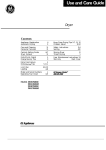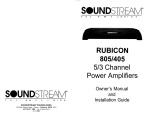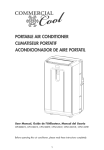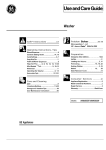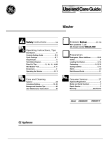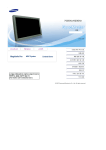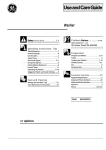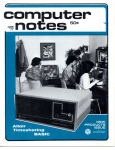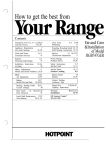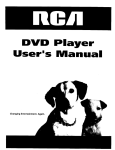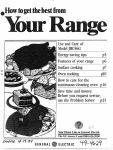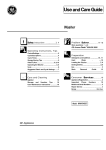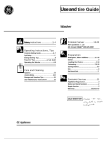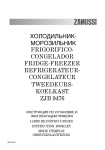Download GE WWA8657R User's Manual
Transcript
Washer
❑
❑
!
Safe~ Instructions
....................3, 4
Operating Instructions, Tips
Bleach Dispenser . . . . . . . . . . . . . . . . . . . . . . . . . . . . . . . . . . . . . . . . . 10
Controls Setting Guide ............................,8, 9
Cycle Setiings.............................................6,
7
Energy-Saving Tips . . . . . . . . . . . . . . . . . . . . . . . . . . . . . . . . . . . . . . 11
❑
m
m
●
Problem solver
......................21 - 25
More questions ?...call
GE Answer Centera 800.626.2000
Preparation
Detergents, Other Additives . . . . . . . . . . . . . . 14-18
Hard Water . . . . . . . . . . . . . . . . . . . . . . . . . . . . . . . . . . . . . . . . . . . . . . . . . . . . 17
Filter-Flo@ Pan ............................5, 10, 13,25
Loading the Washer................................5,
Operating the Washer ...........................5-1 O
Pretreating
13
..................................,......9, 12, 18
Sorting Clothes ........................................5, 12
Stains . . . . . . . . . . . . . . . . . . . . . . . . . . . . . . . . . . . . . . . . . . . . . . . . . . . . . . . . . . . . . . 19
.~~;: Care and Cleaning
Agitator . . . . . . . . . . . . . . . . . . . . . . . . . . . . . . . . . . . . . . . . . . . . . . . . . . . . . . . . . . . 25
Limestone Buildup . . . . . . . . . . . . . . . . . . . . . . . . . . . . . . . 15,25
Storage and Vacation Tips ........................25
User
Maintenance
instructions
................25
✎✠❑
Stain Removal Guide...................................2O
Consumer Services ...................27
Appliance
Registration
..................................2
Model and Serial Numbers ..........................2
Repair Service .................................................2
Warranty ........................................8ack
\
GE Appliances
Models:
Cover
WA8657R WA8689R /
~LP US ~LP YOU...
Read this book carefully.
Save time and money.
It is intended to help you
operate and maintain your
new washer properly.
Keep it handy for answers
to your questions.
If you don’t understand something
or need more help, write (include
your phone number)
Consumer Affairs
GE Appliances, Appliance Park
Louisville, KY 40225
Before you request service . . .
check the Problem Solver
section. It lists causes of minor
operating problems that you can
correct yourself.
To obtain a Spanish language
version of this book, call
GE Answer Center@
800.626.2000
consumer information service.
If you received a
damaged washer...
Immediately contact the dealer (or
builder) that sold you the washer.
Para obtener la versi6n en
espafiol de este manual, name a
GE Answer Center@, servicio de
information para el consumidor,
te16fono 800.626.2000.
Write down the model
and serial numbers.
You’ll find them on a label on
the lower left side near the front.
These numbers are also on the
Consumer Product Ownership
Registration Card that came with
your washer. Before sending in
this card, please write these
numbers here:
Model Number
Serial Number
Use these numbers in any
correspondence or service
calls concerning your washer.
WARNING: For your safety the information in this manual must be followed to minimize the
risk of fire or explosion or to prevent property damage, personal injury or loss of life.
—Do not store or use gasoline or other
●
flammable vapors and liquids in the
vicinity of this or any other appliance.
—WUT TO DO ~ YOU S~LL GAS
Do not try to tight any appliance.
c Do not touch any elwtricd switch;
do not use any phone in your balding.
Clear the room, building or area of all
●
tiediately call your gas supplier from a
neighbor’s phone. FOUOW the gas supplier’s
instructions.
M you cannot reach your gas supplier,
M the fire department.
—Wtilation and service must be performed
by a qualified installer, service agency or
the gas supplier.
●
●
Wcupants.
All washing instruction terms in this book conform to the Care
Labeling Rule established by the Federal Trade Commission, January 1984.
If You Need Service
To obtain service, see the
Consumer Services page
in the back of this book.
We’re proud of our service and
want you to be pleased. If for some
reason you are not happy with the
service you receive, here are three
steps to follow for further help.
2
First, contact the people who
serviced your appliance. Explain
why you are not pleased. In most
cases, this will solve the problem.
NEXT, if you are still not pleased,
write all the details—including
your phone number—to:
Manager, Consumer Relations
GE Appliances, Appliance Park
Louisville, KY 40225
FINALLY, if your problem
is still not resolved, write:
Major Appliance Consumer
Action Panel
20 North Wacker Drive
Chicago, IL 60606
A
WARN~G-To reduce the risk
of fin, electric shock, or injury to
persom when using your appliance,
follow basic precautions, including the following:
Use this appliance only for ib intended purpose
as described in this Use and Care Book.
●
c This washer must be properly
‘~;b ,
installed and located in accordance
w
@
with the Installation Instructions
before it is used. If you did not receive an
hstallation Instructions sheet with your
washer, you can obtain one by calling, toll
free, the GE Answer Center~800.626.2000.
—Properly ground to conform with all
governing codes and ordinances, Follow
detiils in hs~lation Instructions.
—Install or store where it will not be exposed
to temperatures below freezing or exposed
to the weather.
<onnect to a properly rated, protected and sized
power supply circuit to avoid electrical overload.
<onnect to adequate plumbing and drain
facilities as described in the Installation
Instructions.
Turn off water faucets when the washer is not in
use to relieve pressure on hoses and valves, and
to minimize leakage if a hose or valve should
break or rupture.
When disconnecting Mis appliance
, pull by the plug rather than the cord to
./
%4 avoid damage to the cord or junction of
.4
cord and plug. Make sure that the cord
is located so that it will not be stepped on, tripped
over or otierwise subjected to damage or stress.
Do not repair or replace any part
of the appliance or attempt any
servicing unless specifically
recommended in this Use and Care Book or
in published user-repair instructions that you
understand and have the skills to carry out.
●
●
●
To ~nhnhe the possibility of injury:
●
~.
4
Do not mix chlorine bleach with
ammonia or acids such as vinegar andor
rust remover. Mixing can produce a
toxic gas which may cause death.
Do not wash or dry articles that
\ have been cleaned in, washed in,
~ / soaked in, orspotted with
combustible or explosive substances
(such as wax, paint, gasoline, degreasers, drycleaning solvents, kerosene, etc.) which may
ignite or explode. Do not add these substances
to the wash water. Do not use these substances
around your washer an~or dryer during
operation.
J,
A
●
A
WARNING—HYDROGEN GAS
is produced by the chemical action
within your water heater and the gas
can accumulate in the water heater andor water
pipes if hot water has not been used for a period
of two weeks or longer. HYDROGEN GAS CAN
BE EXPLOSIVE UNDER THESE
CIRCUMSTANCES, So to prevent the
possibility of damage or injury, if you have not
used hot water for two weeks or more, or move
into a residence in which the hot water system
may not have been used for some time, turn on
all hot water faucets and allow them to run for
several minutes before using any electrical
appliance which is connected to the hot water
system. This will allow any hydrogen gas to
escape. Since the gas is flammable, do not
smoke or use an open flame or appliance
during this process.
Never reach into washer while it is
<< moving. Before loading, unloading
.< > or adding clothes, push in the Cycle
Q%
Selector knob to OFF position, then
wait until the machine has completely stopped
before opening the lid.
●
Close supervision is necessary if
this appliance is used by or near
5
children. Do not allow children
to play inside, on, or with this
P%
~G
appliance or any discarded
appliance. Dispose of discarded appliances and
shipping or packing materials properly. Before
discarding a washer, or removing from service,
remove the washer lid.
●
(continued next page)
3
WORTANT SMEH ~STRUCTIONS
(continued)
Keep all laundry aids (such as
detergents, bleaches, fabric softeners,
etc.) out of the reach of children,
preferably in a locked cabinet,
Observe dl warnings on container
labels to avoid personal injury.
Keep the area around and underneath
your appliances free from the
accumulation of combustible materials,
..,
*
such as lint, paper, rags, chemicals, etc.
Keep the floor around your appliances clean and
dry to reduce the possibility of slipping.
To minimize the possibility of electric
shock, unplug this appliance from the
power supply before attempting any
maintenance or cleaning (except the
removal and cleaning of the lint filter).
NOTE: Turning the Cycle Selector
/“ knob to an OFF position does NOT
disconnect the appliance from the
/“
power supply.
Do not tamper with controls.
●
●
●
●
$3
Do not operate this appliance if it is damaged,
malfunctioning, partially disassembled, or has
missing or broken parts, including a damaged
cord or plug.
s Never climb on or stand on the washer top,
Do not wash fiberglass articles in your washer.
Skin irritation could result from the remaining
particles that may be picked up by clothing during
subsequent washer use.
laundry process can reduce
l’~ The
the flame retardancy of fabrics,
~ / Toavoidsucharesult, thegarrnent
manufacturer’s care instructions
should be followed very carefully.
●
●
h
●
For washer operation
●
Do not leave washer lid up during cycle.
~is will stop the wash and spin action and
prevent completion of the cycle.
●
SAW T~SE
~STRUCTIONS
4
HOW TO OPERATE YOUR CLOTHES WASHER
u
WARNING-To reduce the risk of fire, electric shock, or injury to persons when using your
appliance, read the IMPORTANT SAFETY INSTRUCTIONS before operating this appliance.
\
1
W,,
@
7Cyc,.ExtraL*rgeCapaci~
~
w,m,,m,
,“,”,0,,,,
HeavVDu~2Speed Washer
9
Q
o
C(mtrol panel appearance may vary .rlightly
Sorting and Loading
Sort clothes carefully by fabric
type, weight, color and amount
of soil, according to instructions
in How to Sort Clothes section.
● Remove the
Filter-Flo pan.
The underside
of the lid is
a good place
to-put the pan while
loading or unloading clothes.
●
s Add measured amount of
detergent. See Detergents,
Other Additives section
for information on detergents
and other laundry additives.
● Load clothes into wash basket,
being careful not to overload.
Clothes should be below
retaining ring. See How to
Load Your Washer section for
more information.
● Position the Filter-Flo pan on the
agitator. Lint will collect in the
pan for easy removal when the
wash is finished.
Do not use the Filter-Flo pan
as a wash basket. Do not put
any items to be washed in the
Filter-Flo pan.
● See How to Use Bleach
Dispenser section for information
on the Bleach Dispenser.
● For information on bleaches
and fabric softeners, see Other
Laundry Products section.
● Close the lid. Washer will fill
but not agitate or spin with the
lid open.
●
Setting the Controls
Use the Controls Setting Guide to help you make the
proper selections.
O Select Water Level.
SMALL: Washer is less than 1/2 full of clothes.
MEDIUM: Between 1/2 and 2/3 full.
LARGE: Over 2/3 full.
~ Select WasMRinse Temperature.
@ Push Cycle Selector knob in and turn clockwise to
your selected wash setting.
Regular Cycles automatically provide normal
wash speed and normal spin speed.
Permanent Press and Knits Cycles automatically
provide gentle wash speed and gentle spin speed.
@ Pull Cycle Selector
the washer. If you
:::::::*
‘=
STOP @
setting after
washer has started,
push Cycle Selector knob in to stop the washer
and reset to the new position. Setting can be
changed at any time.
-
5
a
T~S TO HELP YOU SELECT SETT~GS
Regular Cycles—
For most cottons, linens, and work and play clothes.
Longer wash times plus an extra deep rinse, spray
rinse and spin provide thorough washing and
detergent removal.
Permanent Press Cycle—
For loads of synthetic andor de] icate fabrics.
A cold water cooldown helps prevent set-in
wrinkles in permanent press shirts, blouses,
dresses and similar apparel with normal soil.
Knits Cycle—
A combination of agitation and soak provides effective
polyester knits laundering. An early and long spray
rinse cools down fabrics before the washer reaches
maximum spin speed to help prevent wrinkle setting.
Extra Cleaning CyclH
For modern fabrics with heavy or oily soil.
Agitation with extra detergent loosens stubborn
soils, and an automatic extra rinse and spin help
remove any detergent left after the first rinse and spin.
6
I
11//fl
c~
Soak CyclClothes activate in a soaking agent for a short time,
then the water spins out. Washer turns off at end of
Soak Cycle—must be reset for desired wash cycle.
E.traclea
I
What Happens in Each Setting (Approximate Minutes)
Regular Cycles
Cycle
Selector
Settings
Wash
Spin
Rinse
Heavy
Norsual
15
35
3X
11
3X
3X
Light
Soil
Soak
Cycle
5
3X
3X
3
42
I
28
I 20 I
NOTES:
. Total time includes pauses between each phase of the cycle.
● Total time does not include water fill times. Fill times vary depending
on household water pressure and your selected water level.
7
CONTROLS SETTING GUDE
Controls Setting Guide for different fabrics and loads
Load
Wash Water
Temperature
Cycle
Cycle Setting
Cottons and Linens
White/Colorfast
BrightiNoncrrlorfast
Hot or Warm
Warm or Cold
Regular Cycles
Regular Cycles
Normal or Light Soil Setting
Normal or Light Soil Setting
Work Clothes
Heavy soil
Average soil
Hot
Hot or Warm
Extra Cleaning Cycle
Regular Cycles
Set at Start
Normal Setting
Permanent Press, Treated Cottons,
Blends with Cottons
Heavy or oily soil
Average or light soil
Hot
Warm
Extra Cleaning Cycle
Perm. Press and Knits Cycles
Set at Start
Light Setting
Synthetics—Polyester, Nylon,
Acrylic Knits and Woven Fabrics
Sturdy
Delicate
Warm
Warm
Perm. Press and Knits Cycles
Perm. Press and Knits Cycles
P. Press or Knits Setting
Knits Setting
Silks, Wools; Blends of Silk
and Wool
Warm
Perm. Press and Knits Cycles
Knits Setting
Rayon and Acetate
Warm
Perm. Press and Knits Cycles
Knits Setting
Down-filled garments, if machine
washing is recommended
Warm
Perm. Press and Knits Cycles
P. Press Setting
Baby Clothes—Sturdy, such as
Diapers, Nightgowns, Shirts, Pads,
Sheets, Receiving Blankets,
Coveralls
Hot
Regular Cycles
Normal or Light Setting
Baby Clothes—Delicate
Warm
I Perm. Press and Knits CVcles
Knits Setting
Blankets—Wool, Part-Wool, Cotton
Warm
I
5 min. soak, then Light Setting
Regular Cycles
Blankets—Synthetic, Electric
5 min. soak, tben Light Setting
Curtains—DO NOT MACHINE
WASH FIBERGLASS
P. Press Setting
Chenille Bedspreads, Robes*
P. Press or Knits Setting
Slipcovers, Draperies, Bathmats
and Rugs*
Hot or Warm
Regular Cycles
Normal Setting
Denims (especially Indigo Blue
Jeans) and other fabrics that bleed
Cold or Warm
Regular Cycles
Normal Setting
Rubber-coated Items, Laminated
Fabrics, Vinyl, Plastics and
Articles with Plastic Trim
Warm
Perm. Press and Knits Cycles
Knits Setting
Pillows
Warm
Perm. Press and Knits Cycles
P. Press or Knits Setting,
depending on amount of soil.
I
*Check size. Some slipcovers, draperies and bedspreads may be too large for automatic borne-size washer.
8
Bleach
Special Instructions
Liquid chlorine type.
Only n(~l]-chlorine bletich when needed.
II colorfast is unusually soiled, use hot water. Use maximum detergent recommended in
the Detergent Guide.
Whi[c or colorfas[l liquid chlorine [ypc.
Noncolorfast, only norl-chlnrine bleach
when needed.
Use maximum detergent recommended in the Detergent Guide
White (n colorl’ast, liquid chlorine type.
Noncol(n.f’tist, only notl-chlorine bleach
when needed.
Smtill h)ads reduce wrinkling. Use m:ixirnum de[ergcn( recommended in the Detergenl
[;uidc. Use Extra Cleuning (.ycle.
White 01- cotol-ttis(, liquid chlorine (ype
Notlcolorf’as(, only no[l-chlot-ine bleach
when needed.
If’ unusufl]ly soiled, usc hot water. Use maximum
(;uidc. Small loads reduce wrinkling,
No hlcach.
Wash ~,nl) it recommended by the garment nlanufacturcr. Follow ins[rrrctions carefully
scld(nll needed. If’ rtccdcd, USe only
non-chlorine bleucb,
Wash in y<~ur w~sher {)n/j if recommcncicd by the gtirment n~~mri’actorer.
N() bleach
W:lsh f]”equenlly to fluff up the down ~nd rcl;iin the g,;irmcnt’s w~irmth. Wash scpara(e[y. Wet
down gives off’ an odot” which mtiy hc absorbed by other gtirments. odo!” disappears when
gilll]l~n( is dry, Trcd[ tl~:lvily s[)ilccf ;II-CiIS with I Iquid detergcn[ or ptiste made of w:i(er and
White 01 c{)lorl’ast, liquid chlorine type,
You [nay prefet- to usc a tnild type detergent. [10 baby c]othcs separately. P1-etreat sp(~ts.
Rinse di:ipcl-s. nigh[g(~wns, pads and sheets al”(cr LISC. Keep di~pcrs in a covered pail ol’cold
water and c(nldi[ioning agent 1 ike Bora[cem br~nd.
only n(]rl-cbl(nine bleach when needed
You may prefer” to LISe a mild type deterxerlt. Do hand-knit ~~rnlen[s by hired
N() bleach
Fill w~shcr. add deter:cn(, allow to dissol~,e before adding blanket. Do one hlankct at a time
Pretreat heavily soiled spots wi(h liquid detergent.
N() bleach,
on electric blanket, scw a stron: piece of cloth over plug to protect hlanket and washer [’l-on]
darn~~c. Do onc blanket a( u time. P1-etrcat heavily soiled spots with liquid dctct~ent.
White 01- colori”ilst, liquid chlorine type,
Vacuum out [OOSC dirt bef~)re washing.
dc(eI-gcn(
Irccotnmended in the Detergen[
—
White or cotorfas(, liquid chlorine type.
-—
White (n colorfast. liquid chlorine type,
Wash only 2 or 3 rugs or mats J( onc time. Shake bctore washing to remove excess dirt
N<) bleach
For ncw “indigo blue” .jcans, wash at lc:~st 3 times in very snl~ll h~~ds with I’LIII water fill.
Jearls need ample room to move to ;Ivoid whi(c lines a[ creases. May discolor plastic washelptirts. Subsequent washings will reduce discoloration. but will probably never eliminate it.
The st~incd p~rts will not discolor subsequent washing loads.
No bleach
Tumble on FLUFF (No He~t)
NO bletich.
Pillows are made of different rn~(erialsdacron, fiber, foam, polyester, natur~l fea(hers and
down. Many pillows c~n be tnachine washed, but rrrc~r~qftictur(’r.j (clr(, lube/.\ t~zu.sf bl,
,/i,ll,,wtct (,~r,<fi,ll}. If washing is recornrnended. check pillows for weak seams or holes and
mend to prevent escape of feathers or tilling. Fill washer, add detergent and agitate for several
minutes to dissolve detergent. Add two pillows at a time to balance load. Use large water level.
Refer to Garment Manufacturer’s Care Labels
For more information on care labeling, send for “What’s New About CARE LABELS.”
For sale by the Superintendent of Documents, U.S. Government Printing Office, Washington, D.C. 20402.
9
OPEMT~G ~STRUCTIONS
How to Use the Filter-Flo Pan
●
The Filter-Flo pan is the lint .
filter. Position the Filter-Flo
.,,,j.:::i’c::::;:;:+:,..
pan on the agitator after
~gg~: ,~fizy:’’.i,:,.
- .. ,.::.:. .:,.:::,.:-.::.. ... . ..<:.. ..:;.,.
loading clothes into the ,...-, .,.:,.
,$:!: l!,!;!{,
Q
washer. Lint is easily seen ~;:’~<~,~J:J::.:: v;~~~i;\::”
.-’ . . . . .:. .... . ,..,-.,...,.,. . .... . . . .
and removed after the wash
a
is finished.
NOTE: Do not use the Filter-Flo pan as a wash
basket. Do not put items to be washed in the
Filter-Flo pan. Do not place detergent packets
in the Filter-Flo pan.
How to Use the Bleach Dispenser
●
Use this dispenser with
liquid bleach only.
If you prefer to
use powdered
bleach, pour it
into the wash
basket along with
your detergent. Do
not pour p;wdered bleach
into the bleach dispenser.
s Measure bleach carefully. Here are some
recommended amounts:
LARGE WATER LEVEL—1 M cup (310 ml) liquid
SMALL WATER LEVEL—2/3 cup (170 ml) liquid
Pour measured amount of liquid bleach directly into
bleach dispenser.
Do not overfill or allow dispenser to overflow.
Avoid splashing. Undiluted bleach can cause
fabric damage.
Never pour undiluted liquid bleach directly onto
clothes or into the wash basket.
●
●
●
How to Use the Soak Cycle
●
●
SOAK CYCLE
temperature
will automatically
be cold.
For a hot or
warm soak, set the
Wash/Rinse Temp.
control to HOT/COLD or WARM/COLD and
turn the Cycle Selector knob to NORMAL in the
Regular Cycles.
10
●
●
Start the washer. After washer fills and begins to
agitate, push in the Cycle Selector knob and turn to
SOAK CYCLE. Pull out the Cycle Selector knob to
complete the cycle.
For an extended soak, allow the washer to fill and
agitate for a few minutes to dissolve the soaking
agent. Then push in the Cycle Selector knob to stop
the washer (keep lid closed) and allow to soak for as
long as desired. After desired soak period, pull out the
Cycle Selector knob to complete the cycle.
If your clothes and household items don’t look
clean and fresh after washing, you will probably
rewash them.. and that means you’ll waste energy.
Remember to sort your clothes carefully, and load
them properly, select correct cycles, use enough
detergent and choose a water temperature warm
enough to re[ea.ye and get rid of soil.
●
●
●
●
●
Use Hot Wash—up to 150°F.+n a regular basis
only when washing heavily soiled articles-such as
work and play clothes.
Under normal soil conditions, wash in water above
80°F. (27°C.). This generally means using the Warm
Wash temperature setting on your washer
temperatures approximately 90°F.–l 10°F. or hand
com-fortable. If you notice that soil has accumulated
after several consecutive washings, use Hot Wash
occasionally, if safe for fabrics.
Try to wash less often. Save articles of the same type
of fabric until you have a full load.
If you must wash smaller loads, adjust the amount of
water. Small loads should have lower water levels.
Wash in off-peak utility hours. Your local utility can
tell you which are the off-peak hours.
11
—
—
HOW TO SORT CLOTmS
Sort by Surface Texture
‘epara’e
=froma
LINT PRODUCERS—such as terry toweling and
chenille—give up lint.
LINT COLLECTORS—such as man-made fibers and
napped fabrics like velveteen and corduroy—attract
lint. These must be washed separately.
For more information on lint control, see The
Problem Solver section.
Sort by Fabric
‘eparate
efromefro’mfrome
In addition to sorting to
reduce lint collection,
it is recommended
that fabrics of similar
construction be
washed together
whenever possible.
Sort by Soil
Separate
mfromafroma
‘~
Sort by Color
It pays to check and prepare
clothes for washing.
Empty pockets, brush out cuffs,
zip zippers, snap snaps, hooks
and buttons.
Do any necessary mending—rips,
hems, tears.
Check all items for areas of heavy
soil or stain.
Remove stains. See Stain
Removal Guide.
Turn poly knits inside-out to
minimize fabric surface damage.
●
●
●
●
●
EXTRA CLEANING
Special Modern Fabric Cycle for
removable heavy and oily soils.
(See Tips to Help You Select
Settings section for instructions.)
See Stain Removal Guide.
See Controls Setting Guide.
See The Problem Solver section.
Soaking and Pretreating-a good
way to loosen deep soils and stiins.
A thorough soaking with detergent
or special soaking agent is another
way to remove heavy soils,
embedded dirt and even some stains.
Soaking can be either a completely
separate washing step or a
preliminary step to a complete wash
cycle. For detailed information on
how to soak in your washer, see
How to Use the Soak Cycle.
FOR INFORMATION ON
SOAKING AGENTS, see Other
Laundry Products Guide.
Pretreat heavy soil by rubbing
in a small amount of liquid
detergent or a paste made of water
and powdered detergent or soap.
For best results, wait 1/2 hour
before washing.
●
This illustration, with clothes just
reaching the Clothes Retaining
Ring, shows a proper load. Clothes
have ample room to move because
they are not packed down, nor
wrapped around the agitator,
Clothes ~re loaded dry since wet
itenls tire Iikcly to pack down which
encourages overloading. This size
load requires a ~LI]l water fill.
What is the best size load of
clothes—large, medium, or
small? Save time, energy and
detergent by avoiding extra use of
the washer. Try to wash a full load
of clothes. [f you can it is better to
save clothes until you have a full
load, If you must wash smaller
loads, save water, energy and
detergent by adjusting the water
level for the size of the load. See
Operating Instructions.
Load clothes dry.
Take a properly sorted group of
clothes and drop them loosely in
the wash basket in this order:
~ Large Itelns—like sheets. Do
not wrap around the agitator,
9 Small [terns-like washcloths.
●
●
~ Medium Size Items–1ike
towels.
To Add Items After the Washer Has Started
●
●
●
●
Turn off the washer.
Carefully remove the
Filter-Flo pan.
Add any additional articles
by submerging them next to
the agitator.
Replace the Fi lter-Flo pan
and restart the washer.
NOTE: When washing stockings,
panty hose and other easily tangled
items, always htindle separately. To
minimize tan~ling. we recommend
the use of a n~t la~ndry bag.
Special Recommendations for Washing Permanent Press If You Do Not Have a Dryer
If you are machine-washing Permanent Press clothes
that you plan to line dry or drip-dry, use extra care to
minimize wrinkling in the wash process:
“ Be careful not to overload washer. Permanent Press
clothes must have ample room to move freely. A
Medium size Permanent Press load is the largest that
should be washed.
●
●
Use more water than you would for a regular load.
Use a Medium Water Level for a Small Load; a
Large Water Level for a Medium Load.
Remove clothes promptly as soon as washer stops
and hang immediately.
13
SELECT~G DETERGENTS AND SOAP
Products
Advanhges
Disadvw&ges
PhosphatePowdered Detergents
Perform well in hard or soft water.
Are not available in some areas.
Non-Phosphate–
Powdered Detergents
Wash all types of fabrics well.
Can be used in hot, warm, or
cold water.
Perform satisfactorily in soft
or moderately hard water.
Generally do not clean well in
hard water.
In some areas only non-phosphate
products are available.
May be difficult to dissolve,
especially in cold water.
Should not be used in cold water.
Those containing sodium
carbonate as an ingredient may
cause harmful limestone deposits
on clothes and washer when
combined with hard water.
(See Detergents section.)
Liquid Detergents
Perform well in soft water.
Offer better performance in
hard water than powdered
non-phosphate types.
May not perform as well as
powdered phosphate products
when diluted in wash water.
Clean synthetics and fabric
blends well.
Are excellent as concentrates
for removing spots.
Completely dissolve even in
cold water.
Soaps
Perform well in soft water.
Generally do not clean well in
medium-hard or hard water.
May combine with water
hardness minerals to form
sticky soap curd.
14
Is your water hard? If it is, and if you use a carbonate type non-phosphate detergent, you will most probably notice
limestone* deposits on your clothes and washer surfaces. The hardness of your water and your washing frequency
will determine how rapidly the limestone will build up. If your water is VERY HARD (11 or more grains) and if
you wash just a few loads a week, you may see limestone buildups in just a few months.
Effecb on Clothes
Although limestone buildup occurs more rapidly on
cotton, it will eventually affect various fabrics in the
following ways:
Gives a stiff, harsh, rough feel to fabrics such
as toweling.
Causes colors to fade and become dull and dingy.
Causes graying of fabrics.
Leaves a white, powdery residue on
dark-colored items.
“ Causes spot-fading of bright colors as a result of
direct contact with detergent.
Reduces wrinkle-resistance of permanent
press fabrics.
Destroys effectiveness of flame-retardant finishes on
cottons such as children’s sleepwear.
Increases fabric wear because of the scrubbing action
between limestone deposits on the fabrics during
washer agitation.
Effects on Washer
Recommended Methods to Reduce
Limestone Buildup
●
●
●
●
Unsightly buildup on all washer surfaces exposed to
the wash solution.
Mat-1 ike, crusty formations caused by lint adhering to
the sticky limestone deposits.
Increased service calls because of limestone deposits
in the pump, recirculation water hoses, filters and
other washer parts.
c Reduced useful life of washer.
●
●
●
●
●
●
c Use a powdered phosphate detergent or a liquid
detergent if these are available in your area.
s Install a home water softener. This will significantly
reduce limestone buildup.
“ Use a packaged non-precipitating water softener,
such as Calgon brand with phosphate.
Good Washing Practices May Delay Limestone Damage to Clothes
The following recommendations will temporarily delay
the effects of limestone on your clothes. These are
generally good washing practices and will give better
soil removal whether or not you have hard water or use
carbonate detergent.
“ Use hotter wash water, for example up to
150°F. (65°C.) for cottons. This also improves
oily-soil removal.
If you wash in cooler water to save energy, use
more detergent to promote better washing. Also
be sure to use bleach on bleachable fabrics. Use
hot water whenever possible.
Add detergent and allow washer to fill and agitate
for three or four minutes to dissolve detergent before
adding clothes.
●
●
Increase amount of detergent. See guide on opposite
page for recommended detergent amounts in relation
to water hardness.
c Increase use of bleaches, presoaks, packaged water
conditioners, prewash soil and stain removers to
help in removing stubborn soils and stains.
Use greater care in sorting loads. Wash very dirty
loads separately and increase detergent to help
keep dirt from redepositing on less soiled items.
Wash delicate items separately to prevent damage
from heavy, sturdy clothes.
Wash smaller loads to increase cleaning action
of washer.
Use fabric softener to counteract stiffness or
harshness in clothes.
●
●
●
●
*LIMESTONE–technically called CALCIUM CARBONATE–is caused by the
reaction of the calcium in the hard water with the sodium carbonate in the detergent.
(cor,tinued next page)
15
——
THE RESULTS OF CONTINUED
USE OF CA~ONATE DETERGENTS
(continued)
How to partially restore clothes
Once clothes have developed limestone deposits,
they may be partially restored by soaking in a solution
of two cups (480 ml) of vinegar in one gallon (3.8 liters)
of hot tap water for 15 minutes. USE A PLASTIC
CONTAINER. Then wash clothes in the washer
using detergent.
CAUTIONS:
“ Do not use vinegar soak solution in washer. The
acidic action of the vinegar may damage the
rrorcelain.
Vinegar soak solution may reduce the
wrinkle-resistance of permanent press fabrics.
I .Vinegar soak maydamage the dyes in some fabrics.
I
,
●
I
HOW MUCH DETERGENT SHOULD YOU USE?
The use of a sufficient amount of detergent is one of the most
important things you can do to make sure your wash comes out clean.
Amount required varies
according., to:
hardness
Amount of soil
:: Size of load
4. Type of detergent
.5 . Wash temperature
Use more detergent if you have...
1. Hard water
2. Large loads
3. Greasy or oily soils
4. Lower wash temperature
5. Low phosphate detergent
1.
Water
7
How to use detergent—
granular or powdered:
For best results, add detergent
to the wash basket before loading
clothes. If you load your clothes
first, add detergent next to
the agitator.
If your detergent doesn’t dissolve
well, predissolve the detergent in
hot water, then pour directly into
the wash basket.
If the recommended amount of
detergent produces too many suds,
switch to ~ low sudsing detergent
brand, and follow instructions
on package.
Using too little
detergent is a
common cause
=
~
of laundry
m
problems: Always
measure detergent w
in a standard measuring cup.
Recommended Amount of Detergent for Average Soil Load
I
High-Sudsing
Powder ~pe
II
Water
Hardness
Large
Me(iium
small
VERY HARD
1 ()-20 Grains
2 cups
(480 ml)
1 x cups
(420 ml)
1 \4 cups
(300” ml)
HARD
4-1 () Grtiins
I x cups
(420 ml)
I Yl cups
(360 ml)
3/4 cup
(I 80 ml)
son
I cup
(240 ml)
I cup
(240 ml)
1/2 cup
(120 ml)
I cup
(240 ml)
314 cup
(180 ml)
1/2 cup
(120 ml)
()-4 Grains
I.ow-Sudsing
Concentrated
Powder fipe
LIQUID
16
O-10 Grains
I
I
Water Level Setting
O-tOGrai”s
I
FOLLOW PAC~GE DI~CTIONS
1
I
1. Use recommended amount
of detergent for your load
and water hardness as shown
in guide at left.
2. When using other detergent
types—low and normal suds,
powders, liquids, non-phosphate
powders—follow directions
on package.
3. For Extra Cleaning
cycle double the amount
of detergent recommended
in guide.
4. For hard water treatment, see
Hard Water Guide.
Before you can decide what to do about hard
water, you need to know if you have it and, if
so, how hard it is.
If you live in a municipal area, contact your
water company.
If you live in a rural area, or in some suburban areas,
contact your county agent.
The answer will be “you have ‘so many grains’ per
gallon (3.8 liters)” and means this:
O to 3 grains per gallon (3.8 liters)—SOFT
4 to 10 grains—HARD
11 to 19 grains—VERY HARD
20 grains and over—EXTREMELY HARD
●
●
If your water is SO~, you have no problem. You
can use soap or detergent as you prefer and forget
all about hard water. If you have HARD water—less
than 10 grains—and you use phosphate detergent,
you also have no problem.
But, if you have more than 10 grains, you will need
to soften your water with either...
1. An installed water softener in your home, or
2. The use of a packaged water softener.
For information on water softeners, see the
guide below.
Add This Much Water Softener with a Full Water Level
Grains of
hardness
When using
with detergent
When using
with soap
over 30
0-10
10-15
15-20
20-25
25-30
o
1/4 cup
(60 ml)
1/2 cup
(120 ml)
2/3 CUP
(160 ml)
1 cup
(240 ml)
1 cup plus I tablespoon for every 5 grains above
30 (240 ml plus 15 ml for each extra 5 grains)
1/3 cup
(80 ml)
2/3 cup
(160 ml)
314 cup
(180 ml)
1 cup
(240 ml)
I z cups
(360 ml)
I X cups plus I tablespoon for every 5 grains
above 30 (300 ml plus 15 ml for each extra 5 grains)
17
.———
OT~R LAU~RY PRODUCTS
Laundry
Product and ~pe
How to Use it
Special Instructions
Use your bleach dispenser. See How to
Use Your Bleach Dispenser section.
1) Do not pour undiluted liquid chlorine bleach directly into
washer or on dry clothes.
Follow package directions.
Put bleach into washer with detergent.
2) Some of today’s washable fabrics should not be chlorine
bleached such as: 1007. cotton flame-retardant children’s
sleepwear, silk, wool, mohair, spandex, leather, or non-fast
colors. Dilute bleach before using on any fabric.
3) Check Manufacturers’ Care Labels for special
instructions.
1) May be used on all kinds of fabrics.
2) 1s most effective in hot water.
BLEACH
Chlorine liquid
such as Clorox brand
Non-chlorine such as
Clorox 2 brand
FABRIC SOFTENERS
Rinse additive such as
Downy Brand
Wash additive such as
Rain Barrel brand
SANITIZER
Chlorine bleach
such as Clorox brand
Mix recommended amount with one
cup (240 ml) water and add at start of
rinse cycle.
Follow package directions.
Add during wash cycle.
1) Helps make clothes fluffy and soft.
2) Reduces static electricity.
3) Use carefully. Too much may cause staining on
some clothes.
4) Do not pour directly on clothes.
5) For those recommended for adding to the wash cycle,
such as Rain Barrel brand, follow manufacturer’s
instructions exactly.
Use in case of infection and
contagious disease.
See under Bleach above.
Guards against infection by killing most bacteria and
viruses.
WATER SOFTENER
Non-precipitating
such as Calgon brand
Follow package directions.
Add at start of wash cycle.
Suspends hardness minerals in solution, keeping
water clear.
Precipitating such as
Borax brand
Follow package directions.
Use with detergent or soap in wash cycle.
Combines with water hardness minerals to form precipitate
which gives cloudy or milky appearance to water.
SOAK AGENT
Such as Biz brand
Follow package directions.
PRETREATING,
STAIN AND
SPOT REMOVERS
Such as Spray ’n Wash
and K2R brands
Follow package directions. Treat only
heavily soiled areas. Check garments’
c:ire labels for instructions.
CAUTION: Washer control panels and finishes may be
damaged by some laundry pretreatment soil and stain
remover products if such products are sprayed on or have
direct contact with the washer. Apply these pretreatment
products away from washer. The fabric may then be washed
normally. Damage to your washer caused by pretreatment
products is not covered by your warranty.
Follow package directions.
NOTE: Tinted garments may not be
colorfast. Wash separately.
Clean washer to avoid discoloration of next load. Go
through complete cycle (5-minute wash) using hot water,
1/2 cup (120 ml) detergent, I cup (240 ml) bleach. Wipe
exterior parts. Caution: Tinting may discolor plastic in
washer. Subsequent washings will reduce discoloration
but may never eliminate it.
TINTS AND DYES
Powdered such as Rit
and Tintex brands
18
—.
———— —
1. Try to remove stains as soon as possible. The
fresher the stain, the easier it is to remove.
2. Before attempting to remove any stain, take
these steps:
Find the fabric and the finish in the chart on the
next page, and use only recommended methods.
Check the care label instructions that came with
the garment.
●
●
Test stain removal product on a hidden inside
seam or on a sample of the material.
Avoid use of hot water on unknown stains. It can
set some stains.
3. Follow stain removal with a thorough rinsing.
4. Wash with recommended amount of soap or
detergent.
●
●
Stain Removal Hint—Using Chlorine Bleach for White and Bleachable Fabrics
Mix 1/4 cup (60 ml) chlorine bleach with one gallon (3.8 liters) of cool
water—approximately 80°F. (27°C. )—in a sink or pan. Soak stained area
for S minutes and launder in washer.
The Case of the “Invisible” Stain
Food or cooking oils on your synthetic garments
may cause stains which are virtually invisible and
which you may not notice as you put your clothes
into the washer.
If these stains are not completely removed in the wash,
the oily spots may pick up dirt from the wash water.
Then they will become very visible and you may think
they were caused by the wash cycle itself.
Once These Spots Become Visible, How Can You Remove Them?
●
●
Rub in undiluted 1 iquid detergent and let stand 30 minutes.
Rewash using hottest water the fabric can stand.
How Can You Prevent These “After-You-Wash” Stains?
●
●
●
I
Increase the amount of detergent normally used.
Increase water temperature where fabric will permit.
Wash synthetic garments more often.
19
—
STAIN ~MOVAL GU~E
Stain
Other Washable Fabrics
White and Bleachable Fabrics
See Controls Setting Guide.
Adhesives
((hewing GUIII, etc. )
Rub with ice or immerse in very cold water. U.\[, ~full tool” to
[,~irt;jti[iy .Vcr(il?(, ~!j~’ti.s rrrucII llcl[l(,,sit,(, or ,qutrl [l.< I?os.$it]le. Sponge
Same as white and bleachable fabrics.
with a stife dry cleaning fluid, * then Iaundcr.
Antiperspirants,
Deodnrtints
Apply undiluted liquid detergent. Rinse. If stain remains, bleach
according to the Stain Removal Hint on previous page. If cnlor
has changed, you may be able [n rcstme it by sp(mging with
~llll~lollia, ** Rinse thnr(~ughly.
Same as white ~nd bleachable fabrics
except use non-chlorine bleach.
Blood”
Soak in cold water, [hen Itiunder in warm wtiter. If stain rcrnflins,
bleach according to the Stain Removal Hin[ on previous page, launder,
Sp(mge nr soak in cnol water, then
launder,
Ctlocolatc,” ([cam,
Icc Cream and Milk
Soak in cold water. ‘1’rea[ stain wi[h a safe dry cleaning tluid:~;
Soak in c[)ld water. Spungc with a sal’e
cleaning fluid. * Apply undiluted I iquid
detergent, L~undcr in warm water.
Apply undiluted liquid detergent. l~under. dry. Bleach according
to [he Stain RCIIlOVtLl Hint on previous page, Iaundet” and dry.
[’ol’l’ee and Tea
Wi[houl cream: Bleach ~ccording to the S[ain Removal Hint nn
previous page. Ltiunder. With cream: Follow guide directions tnr
Cl”eanl.
Sponge with warm water. It stain rcmains,
apply wat”m glycerine, let stand 30
minutes dnd rinse well. (Jr sp(mgc with a
safe dry cleaning Iluid. i: Launder.
C.osnlc[ics: Eyc Shadow.
Lips(ick, Mascara. Liquid
01- Pancake Makeup. ROLIge,
Powder; Crtiy(m; Grease,
oii. Tar, Cod Liver oil
Trc:it stain with sat’e dry cleaning lluid.”: Apply undiluted liquid
detergent; launder and dry. Bleach accot-ding to the Stlin Removal
Hint on previous page.
Spnnge with a safe dry cleaning Iluid.:’:
Then launder in warm detergent watel-.
}:resh ~l-ui[, [;ruit Juices.
Wine, Vege[ablcs or [:()()cj
Soak stain in cool” water. It’ stain remains, bleach acc(n”ding to the
Stain RcnlL)\al Hint [m previous page, Iauncjcr.
Sp(mgc with warm water. Bleach remaining
stain with m)ll-chjorinc bjcach.
Appjy umtilu[cd liquid cjctcrgerlt. Launder. (Tl”cat mijdcw spots
whijc tjlcy are l’rcsh, bcl’ot-c rnt)ld has a chance (n weaken Iabric. )
jt cithct type stain remains, bje~ch according to the Stain Renlov~j
Hint (m pl-c~ious ptigc, laLIuLJer. (Se\crc sc(nch caurl~)t be removed.)
SNn~ge with Wal-m w’a[cr. Apply u/1[/i/ur~,~/
/i(4[{j~/ ~{(,fc,r,q(,tlf. Bleach remaining stain
with nnn-cj]jorine bjeach, then launder.
Old mijdcw stains can scjdom be
removed. Scm”ch can sejdom
be removed.
Ink. Bajljloint
Fresh stains: Place sttiin face dnwn (m ~n absnrbent tnwej and
spnnge with dry cleaning fluid,:!: ur Ltsc Spl-ay cjeaner. Appjy
undi]crted jiquid detergent. Ojd stains: Bjeach according to the
Stain Rem(~vaj Hint (m previous pfige.
Same as white and bleachtibje Ilibrics
except launder using m)tl-chjorine blcticjl.
I>aint and Varnish
Sol’ten with (~ij, jard or petroleum ,jelly, then sponge with
turpetltine or banana oi 1. Launder in warm water.
Same as white and bjeachable f“abrics.
Pcrspi[-ati(m
Appjy undiju[ed jiquid detergent and launder in warm wa[er. jl
color has changed you may be able [n restore it by treuting with
umtn(mia or vinegar .:~+: jt” any stain rcmains, treut witjl saf’e dry
cleaning tluid* or bleach according tu the S[~in Remuvtil Hint on
previous page, launder and dry.
Launder in w~r[n water. Rinse WCII. Bleach
with non-chlorine bjeach.
Rust
Appjy rust renlnver, ** using manufacturer’s directions. Rinse and
jaundcr.
Same as white and bleachabje fabrics
(.olol-i”g”
(irass, Foliage. Flowers,
Mijdcw, Scorch
A
A
.,
*(;tiu[imr: Because cleaninz Iluids [end t{) be toxic. bc sure vou
are ;n o well vcn[il~ted m(~m when using [hem. Nu clcmrirrg
tluid shorrtd be used untcss user is lamitiar with the limit~tions
and required cautinns (usually printed nn labct). Use extrcme cautiun
wi[h Ilmnmablc cnmpuunds.
Under no circumstances should fabrics containing tlammable materials
(waxes, cleaning fluids, etc.) he washed in washer.
20
**D{) “()[ nlix Chl”rille bleach with annnc)nia nr acids such as vinezar
and/nr rust rcm[)ver. Mixing can prnduce a toxic g~is which may-cause
death.
Save and refer [U garment rnanufticturcr’s care labels.
PROBLEM
POSSIBLE CAUSE
LINT OR RESIDUE
ON CLOTHES
c Incorrect sorting of clothes. Separate lint producers (such as terry towels and chenille)
from lint receivers (such as man-made fabrics, velveteen, corduroy).
Washing too long, especially for smaller loads. For norrnd soil, wash one minute per
pound of dry clothes.
Use of non-phosphate detergents which combine with hardness minerals to form a
precipitate which can be mistaken for lint. Use a phosphate or liquid detergent; use
warmer wash water or soften water with an installed mechanical softener or a
packaged water softener.
Powdery residue from granular detergent may appear to be lint. Predissolve granular
detergent in hot water before adding to washer; make sure detergent is completely
dissolved before adding clothes; switch to liquid or cold water detergent or use
warmer wash water. See Detergent Guide.
Overloading will cause abrasion which creates excessive lint. Wash fewer items at
one time.
Too much bleach. Use correct amount of bleach according to package directions.
Not enough detergent to hold lint in suspension during wash cycle. Increase amount
of detergent. See Detergent Guide.
Incorrect use of fabtic softener. If used in wash cycle, softeners may react with
detergent to create a white deposit. Use softeners in rinse cycle only unless package
specifies adding to wash cycle. See Other Laundry Products section.
Pilling usually on polyester-cotton blends is caused by normal wear and may look like
lint. Turning clothes inside-out may provide some help.
Static electricity caused by overdying will cause attraction. Use fabric softener in
rinse cycle.
●
●
●
●
●
●
●
●
●
GREASY OR OILY
STAINS ON
LAUNDERED
GARMENTS
GRAYED CLOTHES
These are sometimes called “Invisible Stains” because you may not notice them before
washing clothes. However, if oily soils are not completely removed in wash cycle, the
oily spots may pick up dirt from the wash water. The spts will then be very visible. They
are not caused by the washer. Wash synthetic garments as soon as possible after wearing.
Use more detergent than normal and hottest water fabric can stand. If spots appear, rub in
undiluted liquid detergent, let stand 30 minutes and rewash with extra detergent using
hottest water fabric can stand.
●
●
●
●
Insufficient detergent. You may need to increase amount of detergent used if load is
larger than normal, if soils are oily or heavier than average, or if water is Hard to
Extremely Hard.
Water not hot enough for type of load. Be sure water heater is set to deliver hot water to
the washer at 140°F.–1500F. (60°C.450C.). Do not wash when other hot water needs—
such as dishwashing or family baths—are heavy.
Poor or inferior detergent. Change to phosphate detergent, if possible. Follow these steps:
1. Use water conditioner (such as Calgon brand).
2. Pretreat stains.
3. Use the hottest water possible.
4. Use bleach where possible.
5. Use presoak aids.
6. Install water softener.
Washer overloaded. Clothes cannot move freely to loosen and remove soil, causing
gray appearance. Follow correct loading procedures for size of load.
(continued next puge)
r
THE PROBLEM SOLVER
(continued)
PROBLEM
POSSIBLE CAUSE
GRAYED CLOTHES
(continued)
Improper soaking with insufficient detergent. Usually a 30-minute soak is sufficient.
However, when using extended soaks for heavily soiled garments, you may need to use
twice the recommended amount of detergent.
Use of soap in hard water. Switch to a phosphate detergent, or follow six steps at
bottom of previous page.
Washing too long may result in increased soil deposition. Use shorter wash times for
smaller loads.
Detergent dissolves too slowly. Detergent must be present in the wash solution at the
start of agitation. See Detergent, Other Additives section.
To restore grayed clothes, follow one of these procedures:
1, Put clothes in washer. Fill with HOT water. Check Manufacturer’s Care Labels to
determine if hot water is suitable for garment.
Add a non-precipitating type of water softener such as Calgon brand with
phosphate—use 2fi times as much as you need for normal water softening,
Do not use detergent or soap.
Allow clothes to go through complete cycle.
Repeat, if necessary.
2. If you prefer to use the Soak cycle, see How to Use the Soak Cycle section. Use
water softener in place of soak agent or prewash detergent and allow clothes to
soak for about 20 minutes.
3. Use Extra Cleaning cycle, see Tips to Help You Select Settings section.
●
●
●
●
●
●
●
●
●
YELLOWED
CLOTHES
●
●
●
Incomplete removal of body soil due to constant use of insufficient detergent. Check
hem of T-shirt or pillow case. If they are white and center is yellow, it contains body
oil. Restore whiteness following procedures on Grayed Clothes, above.
Chlorine bleach may yellow some fabrics with resin finishes. Use oxygen bleach
(such as Clorox 2 brand). Refer to Garment Manufacturer’s Care Instructions. Restore
color using color remover (such as Rit or Tintex brands), following package directions.
Iron or manganese in water may cause overall yellowing or yellow spots.
1. Use extra detergent plus a non-precipitating water softener dissolved in water
before adding clothes. Use non-chlorine bleach.
2. Have a special filter or chemical feeder installed in your home to remove iron and
manganese from water.
3. Run hot water for a few minutes to clean iron residue buildup in lines; drain water
heater occasionally.
4. To remove spots: Spread stained portion over pan of boiling water and squeeze
lemon juice through stain. To remove overall yellow, use a commercially available
rust scale remover, following package instructions. If porcelain damage can occur,
do not use in the washer; use a plastic container.
BLUE OR GRAY
COLOR STAINS
Improper use of fabric softener. Never pour fabric softener directly on clothes; always
dilute before adding to rinse water. See Other Laundry Products section. To remove
stains: Dampen stained area and rub with undiluted liquid detergent. Rewash, using
chlorine bleach if safe for fabric.
SHRIN~GE,
GENERAL
Some fabrics will shrink whether washed in a washer or by hand; others maybe safely
washed but will shrink in a dryer. Follow Garment Manufacturer’s Care Instructions
exactlv. If in doubt, do not machine wash or drv.
22
PROBLEM
SHRIN~GE,
~ITS
POSSIBLE CAUSE
●
●
●
WRINUING IN
PERMANENT PRESS
AND “NO-IRON”
ITEMS
Relaxation shrinkage can occur in knit fabrics that have been improperly stretched
and elongated by the manufacturer. When this occurs, garment may be pressed back
into shape after each wash and dry cycle.
Progressive or delayed shrinkage is caused when starch or sizing (in some fabrics)
is gradudly removed by laundering. This may also be noticed in older garments that
have been washed many times without previous shrinkage. Treat as for relaxation
shrinkage above.
Shrinkage caused by overheating occurs in certain knit fabrics that have been heatshaped. When washing, drying or ironing temperatures exceed the temperatures used
to shape set, shrinkage may occur. This cannot be corrected, but it can be prevented
by washing in cool or warm water and drying on Low or Delicate heat.
having clothes in dryer after tumbling stops. Remove and hang clothes immediately.
Q Too many clothes in dryer. Dry only one washer load at a time. Do not combine loads.
Improper loads. Avoid laundering heavy Permanent Press items, such as work clothes,
with lighter Permanent Press items such as shirts or blouses. Do not wash Permanent
Press items with regular laundry.
Too many clothes in washer. Permanent Press loads should always be smaller than
regular loads.. .no more than medium loads to give clothes room to move freely.
Repeated washing in too hot water. Wash in cold or warm water with plenty
of detergent.
Accumulation of lime scale due to use of carbonate detergents. If you must use a
non-phosphate detergent, avoid the use of high-carbonate-built detergent.
Failure to use fabric softener. Proper use will minimize wrinkling.
To remove wrinkles:
Retumble on Permanent Press setting.
Rerinse and dry on Permanent Press setting.
If unsuccessful, retumble on high heat for 10 to 12 minutes and hzng immediately.
Send to dry cleaners for pressing.
Some wrinkles may remain which cannot be removed.
●
●
●
●
●
●
●
●
●
●
●
SNAGS, HOLES,
TEARS, RIPS OR
EXCESSIVE WEAR
Pins on garments or sharp objects left in pockets. Check to make sure all such objects
are removed. Also check wash tub.
Snaps, hooks, sharp buttons, belt buckles, zippers. Fasten hooks, zippers and buttons.
Remove sharp buttons and belt buckles. This is especially important in washing knits
which snag easily. Turn knits inside out.
Q Holes with random square shapes with yellow discoloration may be caused by
improper use of chlorine bleach. Use only correct amount of bleach. See Other
Laundry Products section. Never add undiluted bleach to wash tub or allow
clothes to come into contact with undiluted bleach. Do not wipe up bleach
spills with clothes.
Chemicals such as hair bleach, dye, permanent wave solutions, battery acids and
toilet bowl cleaners may cause fabric holes. Rinse all towels and other articles that
came in contact with these chemicals before putting them in wash. Do not
contaminate clothing articles with these chemicals.
●
●
●
(continued next page)
23
THE PROBLEM SOL~R
(continued)
PROBLEM
SNAGS, HOLES
TEARS, WPS OR
EXCESSIVE WEAR
(continued)
POSSIBLE CAUSE
Small, unnoticed tears may enlarge during washing process. Check garments before
washing and mend all rips and tears.
As Permanent Press garments age, they may show fraying at collars and cuffs. This is
normal due to weakening of fibers by the Permanent Press process. It is not caused by
washer. Do not wash heavy items such as towels with Permanent Press. Remove collar
stays, when possible.
Roughness or burrs on agitator may cause rips or tears. Check agitator and fllle rough
spots if necessary.
Garments weakened by age, sun or atmosphere. This is inevitable and is not caused
by washer.
. Too large loads. Load washer only with number of items that will move freely.
●
●
●
●
HEAVILY SOILED
AREAS such as
collars and cuffs
Pretreat with liquid detergent. Use Extra Cleaning cycle, see Tips to Help You
Select Settings section.
WASHER WON’T
OPERATE
@@@@
●
●
●
●
●
WATER
TEMPERATURE
IS INCORRECT
●
●
●
●
WATER WON’T
DRAIN
WATER LEAKS
●
●
●
●
Make sure cord is plugged into outlet.
Make sure both hot and cold faucets are turned on.
Make sure controls are set and Cycle Selector knob is pulled out to ON position.
Make sure lid is closed. Washer will fill but will not spin or agitate with lid open.
Check house fuses or circuit breakers. If another appliance is sharing the electrical
outlet, remove it. Washer should have separate outlet.
*o~{
Make sure hot and cold faucets are turned on and
regulated correctly.
Make sure hoses are connected to correct faucets...
hot to hot, cold to cold.
Water valve screens may be stopped up. Remove inlet
hoses from water valve. Clean the screens and reinstall hoses.
Check house water heater to make sure it is delivering water at
140°F.–1500F. (60°C.–650C.).
Make sure drain hose is not kinked.
Top of drain outlet should be less than 8 ft. (2.4 m) above floor.
Make sure hose connections are tight at faucets.
Make sure end of drain hose is correctly inserted in and secured to drain facility.
24
—.
PROBLEM
POSSIBLE CAUSE
WASHER IS NOISY
●
●
●
WASHER PAUSES
IN CYCLE
Make sure washer is level and firm to the floor with rubber foot pads in place and
front jam nuts tight. See your Installation Instructions.
A sharp, distinctive sound will be heard at the end of each spin period as the motor
stops and the spin brake inside the transmission “locks in.” This sound is normal.
Heavily unbalanced loads can cause the washer to vibrate excessively during spin, and
may cause it to move from its original position. In extreme cases (usually occurs when
washing a single, heavy item or a small load in a tub full of water), the spin basket
may strike the outer tub, creating a loud but harmless noise. To correct, open the lid
and redistribute the load evenly about the wash basket. Close the lid and restart.
Q Washer normally pauses between washing steps. ..such as between wash and spin or
between s~in and rinse.
@
If you need more help...call, toll free: GE Answer Center / 800.626.2000/consumer information service
USER MAINTENANCE INSTRUCTIONS
The ~b. The porcelain is self-cleaning. Leave lid
open after washing to allow moisture to evaporate.
Do not use harsh or gritty cleansers.
The Exterior. Wipe off any spills of washing
compounds. Wipe or dust with damp cloth. Try
not to hit surface with sharp objects.
To Store Washer. Ask service technician to remove
water from drain pump and hoses to prevent freezing.
Do not store the washer where it will be exposed
to the weather.
For Long Vacations. Be sure water supply is shut off
at faucets and drain all water from hoses if weather
will be below freezing.
How to remove the agitator
To remove limestone from Filter-Flo pan
To remove the agitator,
— Cap
snap the cap off and remove
Screw
the screw. Then remove
Agitator
;1
the agitator extender (on
d
Extender
(on some models)
models so equipped)
and the agitator.
—
Agitator
To replace the agitator,
;;,
carefully lower it straight
down onto the shaft so
, .’
A
,.
that it fits snugly into
place. Replace the agitator
—
Shafi
extender (on models so
...
i
equipped), the screw
and the cap.
(Appearance may vary)
—
●
Soak filter pan in a preheated 160°F. (71 ‘C. )
solution of-half vinegar and half water for 15
minutes. Then brush each side of pan with a stiff
bristle brush while flushing with running water.
CAUTIONS:
●
●
Do not soak in porcelain container. Vinegar
can damage porcelain.
Do not exceed 180°F. (82°C. ) or filter pan
may warp.
25
NOTES
Wdll Be There
With the purchase of your new GE appliance, receive the
assurance that if you ever need information or assis~nce
from GE, we’ll be there. Ml you have to do is cdl—toll-free!
GEAnswer Center@
8U&6262UO0
In-Home Repair
Service
888-GE-CARES
floo-432-273fl
A GE Consumer
Service professional
will provide expert repair service,
scheduled at a time that’s convenient
for you. Many GE Consumer Service
company-operated locations offer you
service today or tomorrow, or at your
convenience (7:00 a.m. to 7:00 p.m.
Service Contracts
Whatever your question about any Gl
major appliance, GE Answer Cente@
information service is available to
help. YOUI cdl—and your question—
will be answered prornpdy and
courteously And you can cdl any
time. GE Answer Cente@ service is
open 24 hours a day 7 days a week.
80U-626-2Z4
You cm have the secure feeling that
GE Consumer Service will still be
there after your warranty expires. Purchase a C~E contract while your warranty is still in effect and you’ll receive
a substantial discount. With a multipleyear contract, you’re assured of fiture
service at today’s prices.
~
Telecommunication Device for the Deaf
weekday> 9:00 a.m. to 2:00 p.m. Saturdays). Our factory-trained technicians
know your appliance inside and outso most repairs can be handted in just
one visit.
Patis andAccesories
.—.—. . .. .. .. -,., ----- --“., ,
,..
800-626-2002
Individu& qutified to service tieir
own appliances can have needed
parts or accessories sent direc(.ly to
their home. The GE parts system provides access to over 47,000 parts. ..and
all GE Crenuine Renewal Parts are
fully warranted. VISA, Mastercard
and Discover cards are accepted.
User maintenance instructions
contained in this booNet cover procedures intended to be performed by
any user. Other servicing generdy
shotid be referred to qu&fied service personnel. Caution must be
exercised, since improper servicing
may cause unsafe operation.
“.--...
For Customers Wtih
Special Needs...
80~62&2000
L’pon request, GE will provide Braille
controls for a variety of GE applimces,
.-
and a brochure to assist in Dlanninz a
barrier-free kitchen for per;ons wi&
limited mobility To obnin these item>
free of charge, cdl 800.626.2000.
Consumers with impaired hearing
or speech who have access to a TDDor a conventional teletypewriter may
cdl
800-TDD-G~C (800-833-4322)
to request. information or service.
I
I
YOUR GE AUTOMATIC CLOTHES WASHER
I
WARRANTY
Save
proof of original purchase date such as your sales slip or cancelled check to establish warranty period
WHAT IS COVERED
WHAT IS NOT COVERED
FULL ONE-YEAR WARRANTY
For one year from date of original
purchase, we will provide, free of
charge, parts and service labor
in your home to repair or replace
any part of the washer that fails
because of a manufacturing defect.
LIMITED ADDITIONAL
FOUR-YEAR WARRANTY
For the second through fifth year
from date of original purchase, we
will provide, free of charge,
replacement parts for any part of
the transmjssjon that fails because
of a manufacturing defect. You pay
for the service trip to your home
and sewice labor charges. Or, if
you desire, we will provide a
completely reconditioned
transmission. You pay for the
shop reconditioning labor, the
service trip to your home and
sewice labor charges.
Service trips to your home to
teach you how to use the product.
Read your Use and Care material.
If you then have any questions
about operating the product,
please contact your dealer or our
Consumer Affairs office at the
address below, or call, toll free:
GE Answer Center(R’
800.626.2000
consumer information service
Improper installation.
If you have an installation problem,
contact your dealer or installer.
You are responsible for providing
adequate electrical, plumbing and
other connecting facilities.
●
This warranty is extended to
the original purchaser and any
succeeding owner for products
purchased for ordinary home use
in the 48 mainland states, Hawaii
and Washington, D.C. In Alaska the
warranty is the same except that it
is LIMITED because you must pay
to ship the product to the service
shop or for the sewice technician’s
travel costs to your home.
All warranty service will be
provided by our Factory Service
Centers or by our authorized
Customer Care” servicers during
normal working hours.
Should your appliance need
service, during warranty period
or beyond, call 800-GE-CARES
(800-432-2737).
Replacement of house fuses or
resetting of circuit breakers.
Failure of the product if it is used
for other than its intended
purpose or used commercially.
Damage to product caused
by accident, fire, floods or acts
of God.
WARRANTOR IS NOT
RESPONSIBLE FOR
CONSEQUENTIAL DAMAGES
●
●
●
●
Some states do not allow the exclusion or limitation of incidental or consequential damages, so the above limitation or exclusion
may not apply to you. This warranty gives you specific legal rights, and you may also have other rights which vay from state to state.
To know what your legal rights are in your state, consult your local or state consumer affairs office or your state’s Attorney General.
Warrantor: General Electric Company
If further help is needed concerning this warranty, write:
Manager—Consumer Affairs, GE Appliances, Louisville, KY 40225
This book is printed on recycled pape[
Part No. 113 D5497P288
Pub No. 49-9768
8-92 CG
WWA8657R
WWA8689R






























